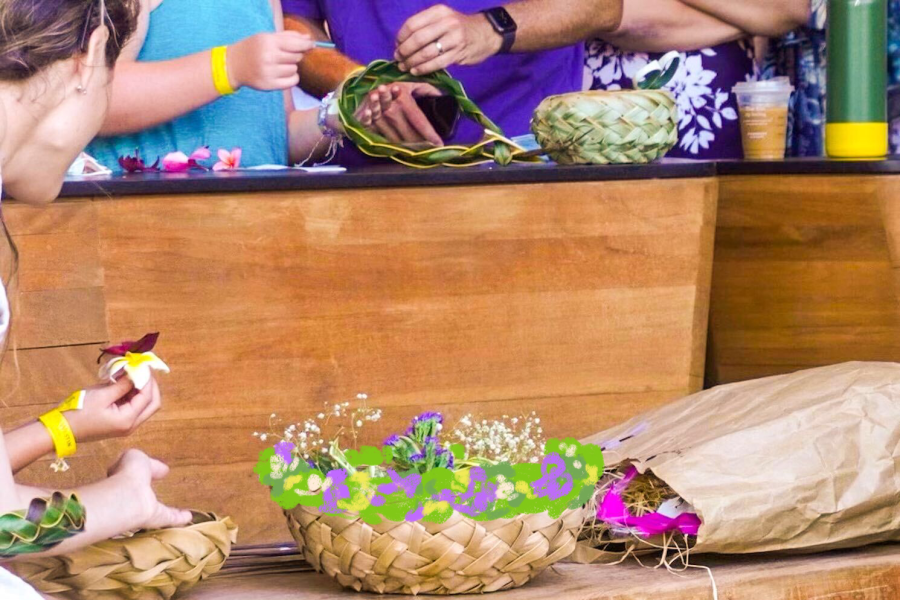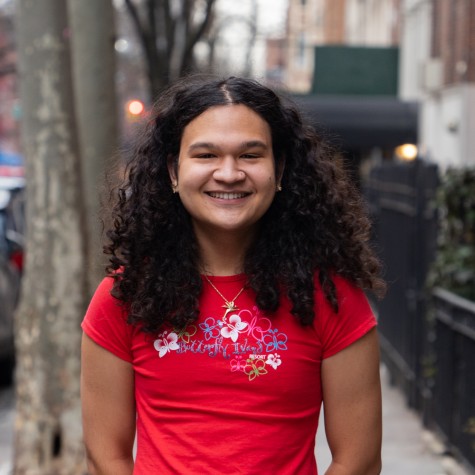May Day is Lei Day in Hawaiʻi
May Day can be a celebration of flowers, lei and aloha — even when you’re not in Hawaiʻi.
In Hawaii, May Day is celebrated on the first of May as Lei Day. The Hawaiian lei serves both as decoration and as a symbol of aloha. (Photo by Roshni Raj, Staff Illustration by Susan Behrends Valenzuela)
April 29, 2022
In the myriad palms of the Hawaiian islands remains a cultural tradition as distinctive as the fragrant blossoms upon its shores. May Day, the first day of May, is a celebration of lei — the Hawaiian garland that serves both as decoration and as a symbol of aloha, the love and compassion unique to Hawai‘i and its native residents.
This rich island tradition of May Day dates back to 1927, when two Honolulu journalists, enthralled by the island’s tradition of giving and receiving lei, sought to set aside a special day to commemorate Hawaiian lei. The creation of this holiday commemorates the cultural and historical relevance of the lei and recognizes the vast knowledge needed to forage for florals, as well as the various intricate sewing and weaving techniques that form a lei.
Growing up on Kauaʻi, otherwise known as the Garden Isle, my elementary classmates and I participated in school celebrations of May Day. Each grade level showcased their own performance of a local island song accompanied by a dance or a traditional hula — the Hawaiian style of dance as synonymous with Hawaiʻi as the lei.
While some schools make participation mandatory, others celebrate May Day by electing a royal court where students represent each of the eight main islands. Students perform hula while adorned in their island’s respective lei and color. While wearing gray malo attire and a hinahina lei, my sixth-grade self represented the island of Kahoʻolawe as its prince. While my hula routine — which commemorated the sails of the Hōkūleʻa, the Hawaiian voyaging vessel — has escaped my memory, the fragrance of lei throughout the event remains cherished and not forgotten.
Lei are significant in the Hawaiian islands, and the practice of celebrating May Day as Lei Day weaves the islands together in a garland of unity. As celebrations of a Hawaiian May Day aren’t common in New York City, some NYU students from Hawaiʻi reflected on their experiences celebrating May Day back home.
“I celebrated May Day for a very long time, for as long as I could remember,” Gallatin first-year Cheyenne Bajo said. “I actually grew up loving flowers, especially plumeria … so I would string them with my grandmother and on May 1, I would go to school with leis and I would give them to my teachers.”
Bajo hails from Wahiawā, Oʻahu, and delicately plucks only the most choice flowers with the permission of the land and afterthought for the next forager, she explains. This ritual of gathering flowers from her ʻāina (land) and sewing it together shows that, for Native Hawaiians, the craftsmanship behind lei-making is more significant than the vivid, tourist adornment it has become.
“Especially coming from a Hawaiian school, I can really relate my relation to all of my friends, kumu [teachers], and everybody I’ve met to, really, a lei,” Bajo said. “If you string these moments, these pua, these flowers together and you create a lei, something so beautiful and something that, you know, doesn’t always last forever, but you’ll always remember it.”
Bajo’s love for May Day began when she performed for her grade school’s celebration of the holiday. Representing the island of Niʻihau as its princess, she enthusiastically honored the tradition of Lei Day so adored in Hawaiʻi.
“Being able to represent the Hawaiian culture as a Hawaiian person even at the mere age of, I think it was like 8 or 7, it was just so important and that kind of kick-started my love for May Day,” she said.
It was through these May Day hula performances — such as my own fourth-grade rendition of the classic Kauaʻi song “Hanohano Hanalei” — that we learned the importance of hula, and how our hands mimicked the natural world around us: the opening of aromatic flowers, the drenching sea-spray and the torrential rain of Hanalei town.
“And it was just something that kind of really connected everybody because that’s one day where you aren’t afraid to just go up to somebody and be like, ‘Oh … here’s a lei’ — it’s normal,” Bajo said. “And that’s kind of what my family does, we just sit down and we make lei, we talk story and then we give it to random people.”
Tisch junior Manu Trujillo, from Kapahi, Kauaʻi, also grew up celebrating May Day and fell in love with the lei-making process. They believe you have a responsibility to learn Hawaiʻi’s history, especially if you went to school on the islands like Kauaʻi.
“I love making lei,” they said. “I’m not great at it but I really like it. And my mom’s a little bit the same way that I am … She feels like she moved to Hawaiʻi and so it’s her duty to kind of like learn everything she can and try to like, honor the land as best as you can.”
Growing up, Trujillo, who identifies as Chicano, was required to participate in May Day. As a teenager in Hawaiʻi, Trujillo remembers being frustrated about the disproportionately fewer opportunities they had in Hawaii in comparison to those on the mainland in the 48 contiguous U.S. states. Although they resented the island and its related Lei Day traditions growing up, Trujillo says they would now do anything to experience such cultural immersion.
“In middle school, I was in between phases where I was really eager to learn more about Hawaiʻi, and also at the same time really rejecting that this was the place that I had been born and raised because, you know, it’s kind of hard growing up there sometimes,” Trujillo said. “The fact that I was complaining about having regular hula lessons for two months in the spring, you know, like, what I wouldn’t give to walk into a hālau [hula school] now.”
Maintaining these cultural traditions becomes important when you’re so far away from home. However, this distance from the tradition’s origin often allows for our small island community to be misrepresented in more mainstream depictions of Hawaiian culture.
Bajo and Trujillo have both been disappointed in the misrepresentation of lei in places outside of Hawaiʻi.
“I love the attempted camp but nothing unsettles me quite like a tiki bar,” Trujillo said regarding the cellophane lei they often see at Hawaiian-themed parties. “It’s freaky. It’s freaky to see something that is so very real just funhoused like that.”
Bajo was saddened to see the misrepresentation of her culture in both food and lei while attending a Lūʻau celebration this year hosted by Third Avenue North Residence Hall.
“I really hate the fake lei — I really do,” Bajo said. “And that kind of just represents how easy it is to misrepresent something. Especially when NYU had their … lūʻau meal and it was literally just like pineapple on pizza and really bad poke. They had the fake lei there. It’s so easy to just half-ass something.”
Despite faulty misrepresentations and the absence of authentic Hawaiian portrayals outside of the islands, Bajo still looks forward to celebrating May Day, which she says is one of her favorite days of the year.
“I think it’s going to be important this year because, for the past two years, graduation wasn’t really a thing, so this season of giving lei hasn’t happened in like two years,” she said. “So I’m excited to see that come back.”
The aroma from a Hawaiian May Day is a fragrance I continually find myself chasing, whether it be in the flower section of a nursery or the floral perfume section of Sephora. The best-smelling lei are strung together with my favorite blooms: sweet pīkake (Arabian jasmine), puakenikeni (perfume flower), pua melia (plumeria), pua kiele (gardenia) and awapuhi (ginger) to name a few.
In New York City where aromas are plentiful but fragrant ones rare, it’s difficult to celebrate this day of giving and receiving lei. But the importance of the lei and the celebration of May Day as Lei Day will forever be a cherished memory. And seeing the tulips and sweet-smelling hyacinths bloom down Park Avenue reminds me of the beauties and fragrances akin to those which I left behind in my fair Hawaiʻi.
Contact Derek Kamakanaaloha Soong at [email protected].

























































































































































